The SandForce Roundup: Corsair, Kingston, Patriot, OCZ, OWC & MemoRight SSDs Compared
by Anand Lal Shimpi on August 11, 2011 12:01 AM ESTAnandTech Storage Bench 2011
Last year we introduced our AnandTech Storage Bench, a suite of benchmarks that took traces of real OS/application usage and played them back in a repeatable manner. I assembled the traces myself out of frustration with the majority of what we have today in terms of SSD benchmarks.
Although the AnandTech Storage Bench tests did a good job of characterizing SSD performance, they weren't stressful enough. All of the tests performed less than 10GB of reads/writes and typically involved only 4GB of writes specifically. That's not even enough exceed the spare area on most SSDs. Most canned SSD benchmarks don't even come close to writing a single gigabyte of data, but that doesn't mean that simply writing 4GB is acceptable.
Originally I kept the benchmarks short enough that they wouldn't be a burden to run (~30 minutes) but long enough that they were representative of what a power user might do with their system.
Not too long ago I tweeted that I had created what I referred to as the Mother of All SSD Benchmarks (MOASB). Rather than only writing 4GB of data to the drive, this benchmark writes 106.32GB. It's the load you'd put on a drive after nearly two weeks of constant usage. And it takes a *long* time to run.
1) The MOASB, officially called AnandTech Storage Bench 2011 - Heavy Workload, mainly focuses on the times when your I/O activity is the highest. There is a lot of downloading and application installing that happens during the course of this test. My thinking was that it's during application installs, file copies, downloading and multitasking with all of this that you can really notice performance differences between drives.
2) I tried to cover as many bases as possible with the software I incorporated into this test. There's a lot of photo editing in Photoshop, HTML editing in Dreamweaver, web browsing, game playing/level loading (Starcraft II & WoW are both a part of the test) as well as general use stuff (application installing, virus scanning). I included a large amount of email downloading, document creation and editing as well. To top it all off I even use Visual Studio 2008 to build Chromium during the test.
The test has 2,168,893 read operations and 1,783,447 write operations. The IO breakdown is as follows:
| AnandTech Storage Bench 2011 - Heavy Workload IO Breakdown | ||||
| IO Size | % of Total | |||
| 4KB | 28% | |||
| 16KB | 10% | |||
| 32KB | 10% | |||
| 64KB | 4% | |||
Only 42% of all operations are sequential, the rest range from pseudo to fully random (with most falling in the pseudo-random category). Average queue depth is 4.625 IOs, with 59% of operations taking place in an IO queue of 1.
Many of you have asked for a better way to really characterize performance. Simply looking at IOPS doesn't really say much. As a result I'm going to be presenting Storage Bench 2011 data in a slightly different way. We'll have performance represented as Average MB/s, with higher numbers being better. At the same time I'll be reporting how long the SSD was busy while running this test. These disk busy graphs will show you exactly how much time was shaved off by using a faster drive vs. a slower one during the course of this test. Finally, I will also break out performance into reads, writes and combined. The reason I do this is to help balance out the fact that this test is unusually write intensive, which can often hide the benefits of a drive with good read performance.
There's also a new light workload for 2011. This is a far more reasonable, typical every day use case benchmark. Lots of web browsing, photo editing (but with a greater focus on photo consumption), video playback as well as some application installs and gaming. This test isn't nearly as write intensive as the MOASB but it's still multiple times more write intensive than what we were running last year.
As always I don't believe that these two benchmarks alone are enough to characterize the performance of a drive, but hopefully along with the rest of our tests they will help provide a better idea.
The testbed for Storage Bench 2011 has changed as well. We're now using a Sandy Bridge platform with full 6Gbps support for these tests. All of the older tests are still run on our X58 platform.
AnandTech Storage Bench 2011 - Heavy Workload
We'll start out by looking at average data rate throughout our new heavy workload test:

Our Storage Bench suite groups performers according to die count/drive capacity. The 240GB drives are faster than the 120GB counterparts. There's also not much of a difference between the drives with synchronous vs. asynchronous NAND.
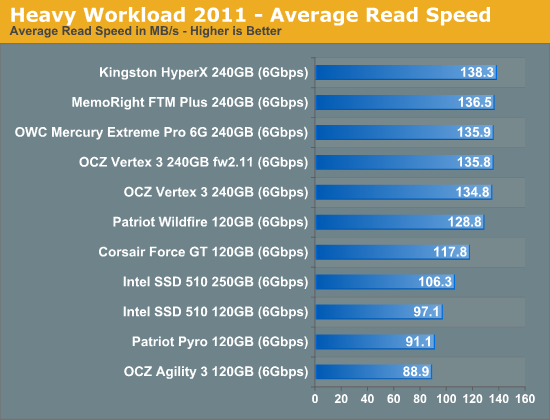
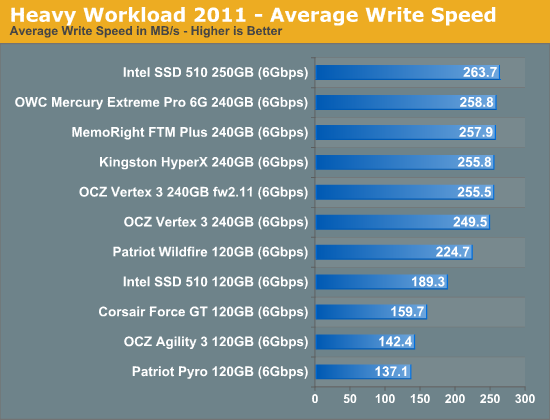
The next three charts just represent the same data, but in a different manner. Instead of looking at average data rate, we're looking at how long the disk was busy for during this entire test. Note that disk busy time excludes any and all idles, this is just how long the SSD was busy doing something:
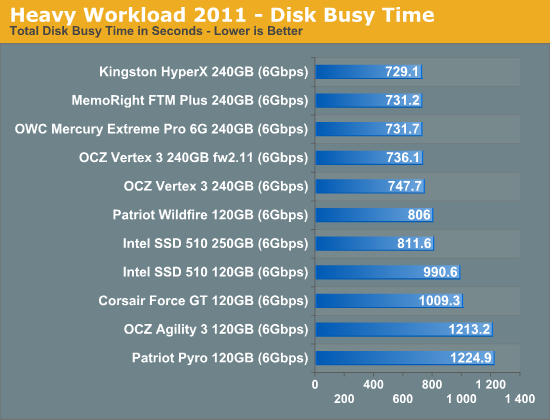
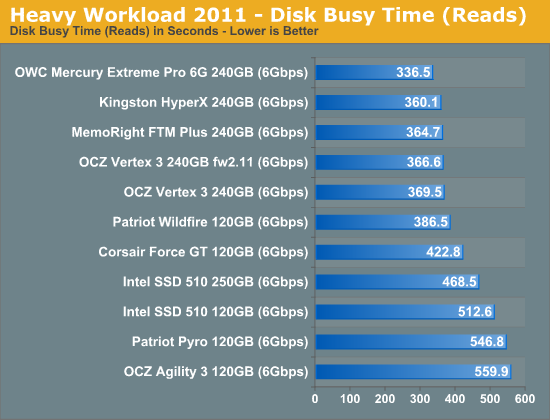
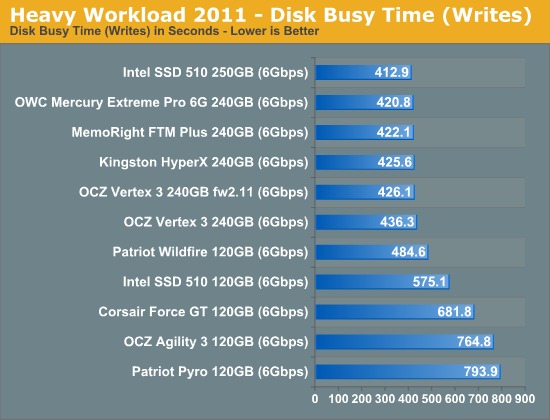










90 Comments
View All Comments
bernardl - Thursday, August 11, 2011 - link
I am pretty surprised by the little mention of the OWC SSD in your introduction and conclusion. It seems to belong to the top 3 perforers in every single of your tests and their product have proven extremely reliable and durable over the years.I am using 3 of their SSDs (Mac pro boot, mac mini boot and external storage for music server) and have experienced zero issue and stable/fast performance.
Cheers,
Bernard
arntc - Friday, August 12, 2011 - link
I'm not sure if I read correctly between the lines; one should stick to the previous generation of consumer SSD's if your on the prowl for a systemdisk in a notebook?If the 3-dimensional comparison of Price/Performance/Reliability is charted, which SSD would currently come out on top (subjective comments allowed)?
86waterpumper - Friday, August 12, 2011 - link
I just bought the 120mb version of the mercury extreme 6g for my sandy bridge build a few weeks ago. I sure wish I had known they were coming out with faster drives :( Oh well so far no bsod issues, and Ihope I don't see one!
FunBunny2 - Friday, August 12, 2011 - link
My understanding is that NAND is measured in bits because the controllers see the data as bits, not bytes, leveling across available (addressable) dies. Yes?vashtyphoon - Friday, August 12, 2011 - link
Thanks for the article, very informative, but it made me cringe.I just placed an order for a PC build based off of the SandyBridge guide, with the OCZ Vertex 2, but I changed the motherboard to a ASUS P8Z68-V LE, same base model as the setup that caused the BSODs with a vertex 3 on page 2.... Is this going to really miss me up or do the Vertex 2s have a better track record?
Any thoughts?
brakhage - Friday, August 12, 2011 - link
I just got 3 OCZ drives, 2 vertex3 60's, and a Solid3 120. I quickly encountered the BSOD/freeze issue on the 2 60s (OS drives). After extensive research and thread-chasing, it seems like OCZ has a solid solution, though it's not simple.Basically, you update RST and INF drivers (and throw in a BIOS update if possible), then flash the firmware (2.11), clear cmos and fire it up. I've been BSOD-free ever since... EXCEPT when I use the Solid3, which I got a few days later, and haven't flashed yet. (I'm using it for additional programs, so when I play a game that's on the Solid3, I freeze up. Maybe. It may be an overclocking issue there, I haven't had time to figure it out. I just got that Solid 3 a couple days ago - the same day I OC'd the new machine.)
Full details on this fix can be found on the OCZ forums; once in a terse post, once in a more verbose one.
So: the firmware flash is a bit of a problem. The tool they provide didn't detect my drives, and it isn't recommended to flash a drive from the OS stored on that drive. I installed windows 7 on a second (spinner) hdd, and tried the tool; it still didn't work. (Maybe because they're in RAID 0?) So I put Ubuntu on the spinner and flashed them through that with no problem.
(The HDD has since been disconnected, and I haven't gotten around to hooking it up again to flash the solid3, but I'll try to do that this weekend - hopefully that will fix this one too.)
All this said, the above posters are absolutely right - this should never have happened. However, I'm WAAYYY too impatient to wait for Sandforce to solve the problem, and that impatience extends to waiting for programs to load or for the system to boot. SSDs are like Linux - freaking awesome, but, yes, they aren't the plug-n-play, fire-up-and-forget, McDonalds-style components we've come to expect when running big name OS's. Frustrating, yes, but totally worth it.
KPOM - Saturday, August 13, 2011 - link
Given the ongoing reliability issues with the Sandforce drives, perhaps Apple is justified in using "slower" Toshiba and Samsung SSDs. I've had SSDs since my 2008 Rev B MacBook Air and haven't had a problem with them (the 2008 had a Samsung, my 2010 a Toshiba, and my 2011 a Samsung).Ao1 - Saturday, August 13, 2011 - link
Lal can you please provide some statistics to back up your claim that the 8MB bug is a plague? How many occurrences of the bug have been reported and how many 310 have been sold?Can you als please confirm why you suspect that Intel have cut corners resulting deficiencies in quality control procedures? Perhaps half of the validation team were made redundant; or is that statement just an outrageous speculation?
mikeyd55 - Saturday, August 13, 2011 - link
In 2011, for a consumer to even have to be concerned about technology issues like this, is very disconcerting and bad for everyone. Don’t release a product when it’s not stable and/or hasn’t been thoroughly tested – even if it has to cost more as a result. It’s cheaper in the end for all! It reminds me of my experiences with cell / smart phones that are continuously released to consumers despite their software / hardware/ firmware not being ready for prime time. Regarding my recent (June ‘11) SSD build: OCZ Vertex 3 MAX IOPS 120 GB (updated to firmware 2.06), no hard drive, Intel DZ68DB mb (updated to second BIOS revision), and Windows 7 Home Premium 64 bit; I’ve been fortunate, so far at least, to not have experienced any BSOD’s, although under this cloud of uncertainty, I’m especially leery of updating mb BIOS, firmware or any drivers until Sandforce gets a true handle on this problem.86waterpumper - Saturday, August 13, 2011 - link
Well I have had two bsods so far just this weekend :( System is a 2500k non- overclocked running in the normal temperature ranges. First bsod happened during a windows update so I chalked it up to that, but the 2nd one happend awhile ago with the system just sitting there idle. Looks like the owc drives for sure are affected too. Now my question is, how do I prove it is the hard drive causing the bsod lol. Also is there any newer firmware than 3.19 out yet to install or what is the fix?